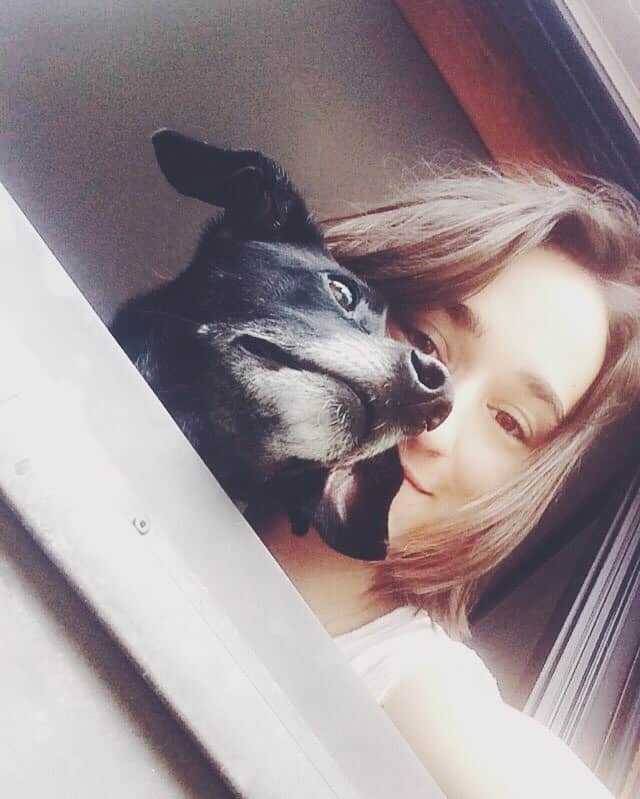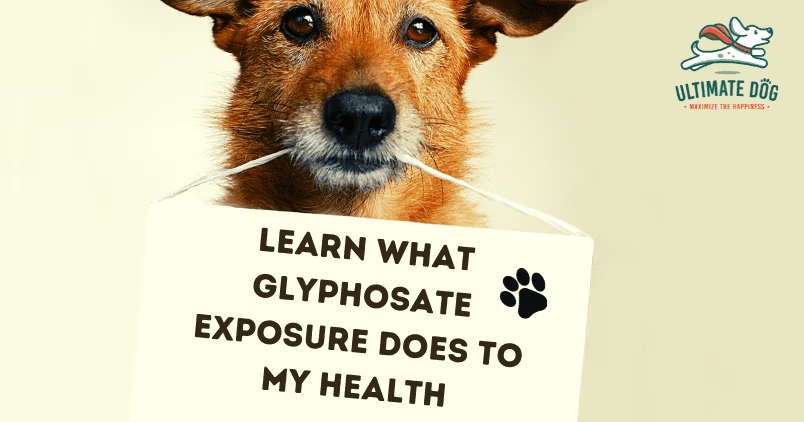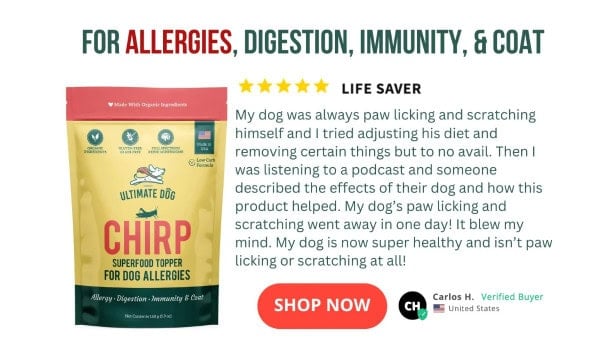Glyphosate is one of the most widely used herbicides in the world. It is used on most farms connected to the global food supply chain and can be predominantly found on fruits, vegetables, grains, and in most brands of dog food. The best known (and best selling) glyphosate-based product is Roundup, manufactured by the infamous Monsanto.
There is an overwhelming amount of research that makes a strong case against using glyphosate in farming. It is plausibly linked to cancer, endocrine disruption, mammary tumors, organ damage, and more. The latest research shows that our dogs are exposed to glyphosate daily, so do we have a cause to worry?
This raises a critical question: How is glyphosate affecting the safety of dog food that we provide to our pets?
The Dangers of Glyphosate in Dog Food
Harming the Gut’s Microbiome
Animal studies in pigs, cattle, and poultry have shown that glyphosate disrupts the balance of the gut’s microbiome – the essential bacteria and other microorganisms that live in the gut and are the building blocks of the immune system. A damaged gut paves the way for weakened health and a variety of serious diseases such as cancer.
When glyphosate disrupts the gut bacteria, the liver is affected. Research shows that glyphosate damages the proper working of the liver by suppressing the enzymes responsible for natural detoxing, which causes toxins to build up in the body. As a result, scientists also connect glyphosate to hormonal imbalance, intestinal inflammation, food intolerances, nutrient deficiencies, allergies, kidney disease, and anemia.
Glyphosate and Cancer
The International Agency for Research on Cancer (IARC) reviewed 1000 studies and concluded with a high probability that glyphosate is carcinogenic. People who were directly exposed to glyphosate at different times and in different areas, even to varying formulations of the herbicide, all developed the same type of cancer – non-Hodgkin lymphoma (a type of blood cancer). In their report, the IARC clearly states that it’s specifically glyphosate causing the issues, not another chemical in the formulation. This was determined through experimental studies on animals that involved pure glyphosate.
Perhaps the most harrowing result of the animal studies is that the studied mice were developing cancer below what is commonly considered a toxic dose. There are several studies examining this issue in particular, whether there is such a thing as a safe glyphosate dose, and they all agree that glyphosate is toxic to all living organisms in smaller doses too. The IARC also reported strong evidence that glyphosate is genotoxic, meaning it can damage the DNA and so lead to cancer.
Glyphosate as an Endocrine Disruptor
The endocrine system contains the most important glands for our dog’s health and functioning, such as the pituitary gland, thyroid gland, pancreas, adrenal glands, ovaries in females, and testes in males. This system regulates hormones in the body and is tied to all critical bodily functions. Therefore, not only can disruptions in the endocrine system cause cancer, but they are also tied to hormonal imbalances, reproductive issues, and birth defects.
I’ve mentioned earlier that glyphosate is still toxic at significantly low doses, and this fact comes up again in studies on endocrine disruption. These studies have found glyphosate to be a big endocrine disruptor, especially in lower doses! For example, a study on human cells showed that glyphosate interferes with the action of androgens and estrogens at a level 800 times lower (!!!) than is allowed in the crops used to feed farm animals in the US.
This is supported by studies on mice and rats, where glyphosate was seen disrupting reproductive hormones. One study looked at how Roundup, specifically, interacts with breast cancer cells and found that it can help them grow. Pure glyphosate gave similar results, at the same level as is permitted in drinking water in the European Union.
A remarkable study on rats exposed them to Roundup in drinking water at half the level permitted in drinking water in the EU and 14,000 times lower than in the US. Over a period of 2 years, the rats developed significant damage to the kidneys, liver, and pituitary gland. They also had an increase of mammary tumors as Roundup shifted the balance in their reproductive hormones. In addition, the researchers noted that the rats exposed to Roundup had higher mortality rates and died earlier than the control group.
Dog Exposure to Glyphosate
There are three primary sources of glyphosate exposure for dogs. The most obvious one, and the one that people usually suspect the first, is surface exposure through lawns, parks, and gardens treated with this herbicide. Direct contact with glyphosate is very toxic to dogs. If they run on the treated lawns and then lick their paws and fur, eat the treated plants, or eat potentially poisoned prey (mice, rats, and other rodents that live in your yard), it’s important to seek veterinary care as soon as possible.
You should also contact a pet poison control center. Some of the warning signs your dog might have gotten directly exposed to glyphosate include drooling, vomiting, diarrhea, apathy, and lack of appetite. The best way to avoid this is prevention, so look into pet-friendly ways to maintain your lawn and treat your garden!
The second source of glyphosate exposure is drinking water. Numerous studies have found glyphosate to be the main contaminant in tap water, and there are even official regulations for how much glyphosate is allowed to be in the water (which is much higher in the US than in the EU), proving that it’s almost impossible to avoid coming in contact with this herbicide. There are, however, several water filters available on the market that can help you purify the water – look for the ones tested specifically for glyphosate!
Researchers estimate that the third way our dogs get exposed to glyphosate is the most widespread one – it’s exposure through commercial dog food.
Glyphosate in Commercial Dog Food
In 2018, a shocking study was published that proved the presence of glyphosate in pet food. Eighteen commercial pet foods from eight different brands were tested, and glyphosate was found in all of them! While the foods were all a mixture of meat and plants, the presence of glyphosate correlated with the fiber content in the food, not protein or fat. This means that plants are likely the main source of glyphosate in commercial pet foods.
Because pet food labels aren’t specific enough in sharing the amount for individual ingredients, the researchers couldn’t determine which plant ingredients are causing the glyphosate presence. Whether the food had meat or plants listed as the main ingredient didn’t seem to affect the results – most of the studied foods had meat listed as the main ingredient.
One of the foods in the study was advertised as non-GMO, so the researchers didn’t expect to find a high presence of glyphosate. But, much to their surprise, not only did this food contain glyphosate as well, but its levels were even higher than in some other foods without a non-GMO label!
A really good point that the study makes is that we need to consider the amount of food our dogs eat daily. On average, the canine exposure to glyphosate through food can be 3 to 12 times higher than estimated human exposure (which is already high enough). So this type of exposure could have very serious long-term effects on the health of our dogs.
But is there proof that glyphosate actually makes it into our dog’s system? What if we’re just paranoid? One study tested the urine of 30 cats and 30 dogs and unfortunately found glyphosate to be the predominant compound in their urine. As a fellow dog owner who has spent most of my life feeding my dogs commercial foods, I found these results very troubling.
Puppies and kittens had a higher amount of glyphosate present in their system than adult cats and dogs. Female dogs also showed higher concentrations than male dogs. Even though some of the glyphosate concentration could be attributed to contaminated water and outdoor surfaces, the researchers believe (in alignment with the study mentioned earlier) that the leading source of glyphosate exposure is the food our pets eat.
Can We Protect Our Dogs From Glyphosate?
You may wonder why this information hasn’t been made more public or why the companies that manufacture this herbicide haven’t taken action yet. The lawsuits against Monsanto (now Bayer) relating to their Roundup product now count at least 125,000 people, and Bayer has to pay billions of dollars in damages to the cancer victims. Uncovered internal documents (known as the Monsanto Papers) have also shown that Monsanto went to great lengths to manipulate the media and misrepresent science to their advantage. Perhaps unsurprisingly, Roundup is the best-selling herbicide on the market and makes the company billions of dollars in revenue.
I know that reading all of this research can be overwhelming, disheartening, and confusing. So the question is: if the big companies aren’t doing anything to protect us from glyphosate, what can we do?
First, if you want to be certain about the extent of your dog’s exposure to glyphosate, there are tests available for that. You can buy a kit online to test your dog’s urine for the presence of glyphosate and find out for sure. Second, examine your dog’s food, research how it’s made, which companies stand behind it, and how the ingredients are sourced. Finally, pay attention to how transparent the company is about the source of its ingredients!
There is also the option of transitioning to a homemade diet (cooked or raw) and using organic produce, as glyphosate is banned in organic farming. Finally, look for a good water filter and a pet-friendly way to manage your garden. Remember that several small changes lead to a bigger change overall! If you only make one tiny change in your dog’s life as a result of this article, it is always better than nothing at all.
Sources
Henderson, A. M.; Gervais, J. A.; Luukinen, B.; Buhl, K.; Stone, D.; Cross, A.; Jenkins, J. “Glyphosate General Fact Sheet.” National Pesticide Information Center, Oregon State University Extension Services, 03/2019.
Robinson Mayer, Kara. “Herbicides and Your Health.” WebMD, 26/04/2021.
“Q&A on Glyphosate.” International Agency for Research on Cancer, 01/03/2016.
“Hormone Hacking.” The Detox Project.
Zhao, Jiang. Pacenka, Steven. Wu, Jing. Richards, K. Brian. Steenhuis, Tammo. Simpson, Kenneth. Hay, G. Anthony. “Detection of glyphosate residues in companion animal feeds.” Science Direct, 12/2018.
Karthikraj, Rajendiran. Kannan, Kurunthachalam. “Widespread occurrence of glyphosate in urine from pet dogs and cats in New York State, USA.” Science Direct, 01/04/2019.
Samsel, Anthony. Seneff, Stephanie. “Glyphosate, pathways to modern diseases II: Celiac sprue and gluten intolerance.” PMC, 12/2013.
Malkan, Stacy. “Glyphosate Fact Sheet: Cancer and Other Health Concerns.” US RTK, 27/09/2021.“Monsanto Papers.” US RTK.

Luna’s passion for learning about canine psychology and behavior began when she adopted a severely reactive puppy from a local shelter. She is now a big advocate for positive reinforcement and compassionate training. As a writer, she strives to spotlight the topics that fly under the radar and be the voice for all who cannot speak for themselves.




Leave a Comment